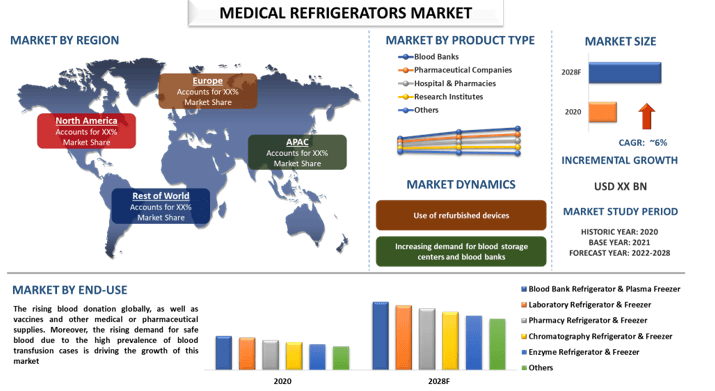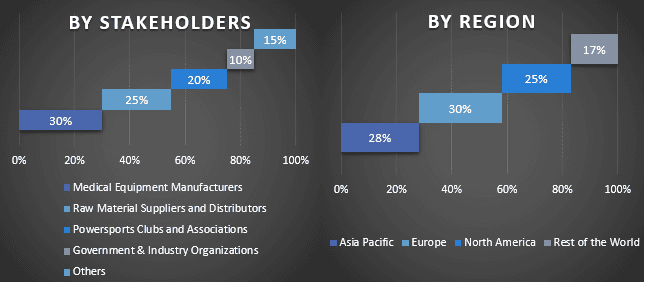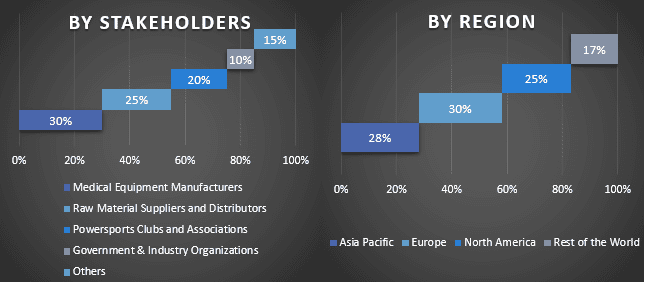Emphasis on Product Type (Blood Bank Refrigerator & Plasma Freezer, Laboratory Refrigerator & Freezer, Pharmacy Refrigerator & Freezer, Chromatography Refrigerator & Freezer, Enzyme Refrigerator & Freezer, and Others); End-Use (Blood Banks, Pharmaceutical Companies, Hospital & Pharmacies, Research Institutes, and Others); and Region/Country.

Global Medical Refrigerators Market is expected to grow at a significant rate of around 5% during the forecast period. Medical refrigerators are used to store different types of samples of biological components such as blood, derivatives of blood, biological reagents, vaccines, medicines, and flammable chemicals. The rising number of medical procedures, combined with the rising pervasiveness of problems including anemia and cancer, is bringing about an expansion in blood transfusion methods. The American National Red Cross estimates that nearly 16 million blood components are transfused each year in the US. The rising demand for blood transfusion will drive market growth. For instance, according to the data published by the American Cancer Society (ACS), in January 2020, around 1.8 million new cancer cases were diagnosed and 606,520 cancer deaths in the United States.
Thermo Fisher Scientific Inc., Haier Biomedical, Helmer Scientific Inc., PHC Holdings Corporation, Follett LLC, Blue Star Ltd, AUCMA Co. Ltd., Standex International Corporation, Godrej & Boyce Mfg. Co. Ltd., and Vestfrost Solutions. are some of the key players in the market. Several M&As along with partnerships have been undertaken by these players to facilitate customers with hi-tech and innovative products/technologies.
Insights Presented in the Report
“Amongst product type, Sport medical refrigerator category to witness robust CAGR during the forecast period”
Based on product type, the market is segmented into blood bank refrigerator & plasma freezer, laboratory refrigerator & freezer, pharmacy refrigerator & freezer, chromatography refrigerator & freezer, enzyme refrigerator & freezer, and others. Among them, the blood bank refrigerator & plasma freezer category witnessed significant growth during the forecast period. This is mainly due to the government initiatives to increase the number of blood units collected, the demand for blood products has risen as the number of hematological disorders and traumatic and road accidents have increased and the high prevalence of blood cancer are the major factors for the market growth. For instance, according to the Leukemia and Lymphoma Society (LLS), approximately, 186,400 people in the U.S. were diagnosed with leukemia and lymphoma in 2021.
“Amongst end-use, the blood banks to hold a significant share in the market in 2020”
On the basis of end-use, the market is categorized into blood banks, pharmaceutical companies, hospital & pharmacies, research institutes, and others. Among these, the blood banks hold considerable growth during the forecast period. This is mainly due to the increasing demand for safe blood and blood derivatives storage. Moreover, companies are rapidly launching novel products in the market, which is also driving the market growth during the forecast period. For instance, in 2019, Lec Medical launched Control Plus which is a new range of medical refrigeration that measures both the core temperature of the fridge, as wsell as the vaccine itself.
“North America to hold a significant share in the market”
For a better understanding of the market adoption of the medical refrigerator industry, the market is analyzed based on its worldwide presence in the countries such as North America (U.S., Canada, Rest of North America), Europe (Germany, U.K., France, Spain, Italy, Rest of Europe), Asia-Pacific (China, Japan, India, Rest of Asia-Pacific), Rest of World. North America accounted for significant market growth. Owing to increasing blood donation, health awareness, high income, reimbursement policies, and well-established healthcare infrastructure are some of the key factors for the growth of this market during the forecast period. In addition, reimbursement policies, and well-established healthcare infrastructure, rising R&D activities, and the presence of the main medical diagnostics companies in North America have energized the regional market. Moreover, the adoption of innovative & advanced technology and a large focus on clinical research drive regional growth during the forecast period. For instance, in August 2019, Helmer Scientific launched professional medical refrigerators with OptiCool cooling technology in its GX Solution Refrigerator line.
Reasons to buy this report:
Customization Options:
The global medical refrigerator market can further be customized as per the requirement or any other market segment. Besides this, UMI understands that you may have your own business needs, hence feel free to connect with us to get a report that completely suits your requirements.
1. Market Introduction
2. Research Methodology Or Assumption
3. Market Synopsis
4. Executive Summary
5. Impact Of Covid-19 On The Medical Refrigerators Market
6. Medical Refrigerators Market Revenue (usd Bn), 2020-2028f
7. Market Insights By Product Type
8. Market Insights By End-use
9. Market Insights By Region
10. Medical Refrigerators Market Dynamics
11. Medical Refrigerators Market Opportunities
12. Medical Refrigerators Market Trends
13. Demand And Supply-side Analysis
14. Value Chain Analysis
15. Competitive Scenario
16. Company Profiled
17. Disclaimer
Research Methodology for the Medical Refrigerator Market Analysis (2022-2028)
Analyzing the historical market, estimating the current market, and forecasting the future market of the global medical refrigerator market were the three major steps undertaken to create and analyze the adoption of medical refrigerator in major regions globally. Exhaustive secondary research was conducted to collect the historical market numbers and estimate the current market size. Secondly, to validate these insights, numerous findings and assumptions were taken into consideration. Moreover, exhaustive primary interviews were also conducted, with industry experts across the value chain of the global Medical Refrigerator Market. Post assumption and validation of market numbers through primary interviews, we employed a top-down/bottom-up approach to forecasting the complete market size. Thereafter, market breakdown and data triangulation methods were adopted to estimate and analyze the market size of segments and sub-segments of the industry pertains to. Detailed methodology is explained below:
Analysis of Historical Market Size
Step 1: In-Depth Study of Secondary Sources:
Detail secondary study was conducted to obtain the historical market size of the medical refrigerator market through company internal sources such as annual reports & financial statements, performance presentations, press releases, etc., and external sources including journals, news & articles, government publications, competitor publications, sector reports, third-party database, and other credible publications.
Step 2: Market Segmentation:
After obtaining the historical market size of the medical refrigerator market, we conducted a detailed secondary analysis to gather historical market insights and share for different segments & sub-segments for major regions. Major segments are included in the report as product type and end-use. Further country-level analyses were conducted to evaluate the overall adoption of testing models in that region.
Step 3: Factor Analysis:
After acquiring the historical market size of different segments and sub-segments, we conducted a detailed factor analysis to estimate the current market size of the medical refrigerator Market. Further, we conducted factor analysis using dependent and independent variables such as various product type and end-uses of medical refrigerator. A thorough analysis was conducted for demand and supply-side scenarios considering top partnerships, mergers and acquisitions, business expansion, and product launches in the medical refrigerator market sector across the globe.
Current Market Size Estimate & Forecast
Current Market Sizing: Based on actionable insights from the above 3 steps, we arrived at the current market size, key players in the global medical refrigerator market, and market shares of the segments. All the required percentage shares split, and market breakdowns were determined using the above-mentioned secondary approach and were verified through primary interviews.
Estimation & Forecasting: For market estimation and forecast, weights were assigned to different factors including drivers & trends, restraints, and opportunities available for the stakeholders. After analyzing these factors, relevant forecasting techniques i.e., the top-down/bottom-up approach were applied to arrive at the market forecast for 2028 for different segments and sub-segments across the major markets globally. The research methodology adopted to estimate the market size encompasses:
Market Size and Share Validation
Primary Research: In-depth interviews were conducted with the Key Opinion Leaders (KOLs) including Top Level Executives (CXO/VPs, Sales Head, Marketing Head, Operational Head, Regional Head, Country Head, etc.) across major regions. Primary research findings were then summarized, and statistical analysis was performed to prove the stated hypothesis. Inputs from primary research were consolidated with secondary findings, hence turning information into actionable insights.
Split of Primary Participants in Different Regions

Market Engineering
The data triangulation technique was employed to complete the overall market estimation and to arrive at precise statistical numbers for each segment and sub-segment of the global medical refrigerator market. Data was split into several segments & sub-segments post studying various parameters and trends in the areas of product type and end-use in the global medical refrigerator market.
The main objective of the Global Medical Refrigerator Market Study
The current & future market trends of the global medical refrigerator market were pinpointed in the study. Investors can gain strategic insights to base their discretion for investments on the qualitative and quantitative analysis performed in the study. Current and future market trends determined the overall attractiveness of the market at a regional level, providing a platform for the industrial participant to exploit the untapped market to benefit from a first-mover advantage. Other quantitative goals of the studies include:

Customers who bought this item also bought